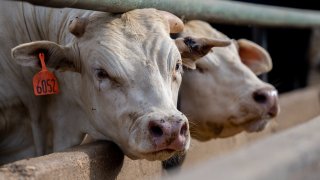
- Retail beef prices in the U.S. are at record highs, pushing up prices of beef-based products from burgers to steaks and steak tartare.
- That's largely thanks to a shrinking cattle supply, as well as higher input costs, market watchers told CNBC. And they don't expect it to ease any time soon.
- Cattle herds in the U.S. have been reduced to their "smallest number in decades" as a result of prolonged drought in key cattle ranching states like Texas and Kansas, Swanson said.

How would you like your steak? Maybe rare, medium, or well done — but certainly not more expensive.
Retail beef prices in the U.S. are at record highs, pushing up prices of beef-based products from burgers to steaks and steak tartare.
Get Tri-state area news and weather forecasts to your inbox. Sign up for NBC New York newsletters.
That's largely thanks to a shrinking cattle supply, as well as higher input costs, market watchers told CNBC. And they don't expect it to ease any time soon.
Retail beef prices are currently hovering around record levels of about $8 per pound, according to data from the United States Department of Agriculture (USDA).
"All consumers will be paying more for all beef products for several more years," Wells Fargo's Chief Agricultural Economist Michael Swanson told CNBC via email.
Money Report
Cattle herds in the U.S. have been reduced to their "smallest number in decades" as a result of prolonged drought in key cattle ranching states like Texas and Kansas, Swanson said.
In its latest livestock report in September, the USDA maintained its forecast that beef production in the second half of this year is expected to decline by 180 million pounds from August to the end of the year.
"As cattlemen retain cows to rebuild the herd, there is a much lower supply of cattle to provide beef," Swanson said.
Ranchers typically raise calves and sell them to a feedlot, where the livestock is fattened and sold to meatpacking companies. There, the cattle are slaughtered and in turn sold to retailers.
However, if ranchers hold on to the cattle longer, it not only reduces the supply of beef, but also adds on to input costs — which eventually get passed on to consumers.
"Input costs have skyrocketed, everything from labor, to transportation has increased packet costs," said Brian Earnest, lead economist for animal protein at farm credit association Cobank.
He, too, echoed how producers have been struggling with prolonged dry weather and poor forage conditions since 2020.
This has contributed to the dwindling cattle population, said Gro Intelligence's Senior Commodity Analyst Adam Speck.
"The last two years, there was a slaughter of reproductive cows … because they couldn't afford to keep them over the winter [due to] drought conditions," Speck told CNBC via telephone.
Supplies of hay, which are water-intensive crops used to feed cattle, were hit by a spade of severe droughts in 2022. In December, dry hay stocks sank to their lowest levels since 1954 at 71.9 million tons.
Most recent USDA figures in May estimated that hay stocks on farms were 13% below that of last year. The USDA only releases assessments of dry hay stocks in May and December each year.
"So the cattle ranchers liquidated the breeding herd … because they couldn't afford to feed them, and that gives us the lowest cattle inventory in nine years," Speck said. That can come in the form of culling the herd.
According to data from Cobank, beef cow slaughter was up 11% year-on-year in 2022 at a total of 3.95 million head. The figure marks the highest since 1996, noted Cobank's Earnest.
"With elevated cow slaughter, has come tighter cattle supplies, and an expectation that domestic cattle supplies will remain tight into the future," he said, projecting that demand for beef is likely to outstrip supply for several years. This means that prices are going to "bump up around record-type levels for cattle" at least over the next 18 months, Earnest added.
"The prices of menu items may go up, including burger patties, as businesses try to maintain their profit margins," Wells Fargo's Swanson said. Prices of burgers may not rise as much as higher-end cuts like steak however, he maintained.
Burger patties are usually made of ground beef, which comprise a mix of cheaper cuts of meat. Beef used in steak generally comes from pricier cuts, like ribeye, sirloin or T-bone.






